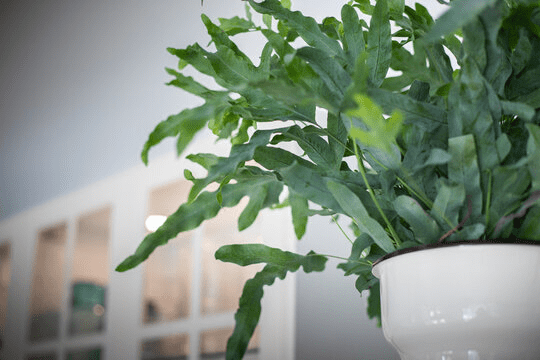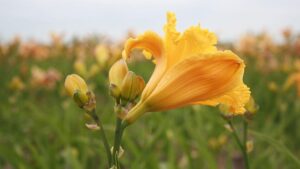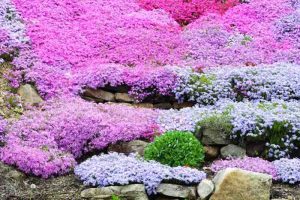Mastering the Art of Growing and Caring for the Blue Star Fern
The blue star fern (Phlebodium aureum) is a beautiful and easy-to-care-for fern that is perfect for adding a touch of greenery to any home.
But what many people don’t know is that this fern is also very low-maintenance, making it a great choice for even the most novice plant parents.With its delicate fronds and striking blue-green color, the blue star fern is sure to turn heads..
In this article, we will discuss everything you need to know about growing and caring for the blue star fern, including:

- Where to place your blue star fern
- How much light and water it needs
- How to fertilize it
- How to propagate it
- How to prevent pests and diseases
By following these simple tips, you can easily master the art of growing and caring for the blue star fern and enjoy its beauty for years to come.
Mastering the Art of Growing and Caring for the Blue Star Fern
The blue star fern (Phlebodium aureum) is a beautiful and easy-to-care-for fern that is perfect for adding a touch of greenery to your home or garden. With its delicate fronds and striking blue-green color, the blue star fern is sure to turn heads wherever it is placed.
Growing Conditions
The blue star fern is a tropical plant that prefers warm, humid conditions. It does best in bright, indirect light, but can tolerate some direct sunlight. The soil should be well-drained and rich in organic matter. Water the plant regularly, but do not allow the soil to become soggy.
Fertilization
Fertilize the blue star fern monthly with a balanced fertilizer during the growing season. Reduce fertilization to once every two months during the winter months.
Pests and Diseases
The blue star fern is susceptible to a variety of pests and diseases, including aphids, mealybugs, and spider mites. To control pests, you can use a neem oil spray or insecticidal soap. If the plant is infected with a disease, you may need to treat it with a fungicide.
Propagation
The blue star fern can be propagated by division. To do this, carefully remove the plant from the pot and divide the roots into two or more sections. Replant each section in a new pot filled with fresh soil.
Care Tips
Here are a few tips for caring for your blue star fern:
- Water the plant regularly, but do not allow the soil to become soggy.
- Fertilize the plant monthly with a balanced fertilizer during the growing season.
- Mist the plant regularly to increase humidity.
- Repot the plant every two years or so as needed.
- Inspect the plant regularly for pests and diseases.
With proper care, your blue star fern will thrive and provide you with years of enjoyment.
Table of Contents
- Growing Conditions
- Fertilization
- Pests and Diseases
- Propagation
- Care Tips
The Blue Star Fern: A Beginner’s Guide
The Blue Star Fern: A Beginner’s Guide
Overview
The blue star fern (Phlebodium aureum) is a popular houseplant that is known for its delicate, fern-like leaves and its striking blue-green color. It is a relatively easy plant to care for, making it a great choice for beginners. However, there are a few things you need to know in order to keep your blue star fern healthy and thriving.
Growing Conditions
The blue star fern prefers bright, indirect light. It can tolerate some direct sunlight, but too much sun can scorch its leaves. The ideal temperature range for a blue star fern is between 65 and 80 degrees Fahrenheit. The plant does not require a lot of water, but it should be watered regularly to keep the soil moist.
Fertilizing
Fertilize your blue star fern once a month during the growing season with a balanced fertilizer. You can use a liquid fertilizer or a slow-release fertilizer.
Pests and Diseases
The blue star fern is not susceptible to many pests or diseases. However, it can be affected by mealybugs and spider mites. Mealybugs can be controlled with a neem oil spray or insecticidal soap. Spider mites can be controlled by spraying the plant with water or by using a miticide.
Propagation
The blue star fern can be propagated by division. To divide a blue star fern, carefully remove the plant from its pot and gently tease the roots apart. Replant the divisions in separate pots filled with fresh potting soil.
Troubleshooting
If your blue star fern is not thriving, there are a few things you can check. First, make sure the plant is getting enough light. If the leaves are turning yellow or brown, the plant may not be getting enough light. Second, check the soil moisture. If the soil is dry, the plant may be underwatered. Third, check for pests or diseases. If you see any pests or signs of disease, treat the plant accordingly.
With proper care, the blue star fern can be a beautiful and long-lived addition to your home.
Choosing the Right Pot and Soil for Your Blue Star Fern
Choosing the Right Pot and Soil for Your Blue Star Fern
When choosing a pot for your blue star fern, it is important to consider the size of the plant and the type of soil it will be growing in. Blue star ferns are relatively small plants, so they do not need a large pot. A pot that is about 6 inches in diameter will be sufficient for most plants.
The type of soil that you use is also important. Blue star ferns prefer a soil that is rich in organic matter and drains well. A good option is to mix equal parts of potting soil, perlite, and peat moss. You can also add a small amount of fertilizer to the soil to help the plant grow.
Once you have chosen a pot and soil, you can plant your blue star fern.
Fill in around the roots with soil and firm it down gently. Water the plant thoroughly and place it in a location that receives bright, indirect light.Gently remove the plant from its nursery pot and place it in the center of the new pot..
With proper care, your blue star fern will thrive and provide you with years of enjoyment.
Here are some tips for caring for your blue star fern:
- Water the plant regularly, making sure that the soil is moist but not soggy.
- Fertilize the plant once a month with a balanced fertilizer.
- Mist the plant regularly to help keep the leaves moist.
- Rotate the plant regularly so that all sides receive equal amounts of light.
- Repot the plant every two years as it grows.
Watering and Fertilizing Your Blue Star Fern
Watering and Fertilizing Your Blue Star Fern
Blue star ferns are relatively easy to care for, but they do require some attention to thrive. One of the most important aspects of caring for a blue star fern is watering and fertilizing it properly.
Watering
Blue star ferns need to be watered regularly, but they should not be overwatered. The best way to determine if your blue star fern needs water is to stick your finger into the soil. If the soil is dry to the touch, it is time to water the plant.
When you water your blue star fern, make sure to do so thoroughly. Soak the soil until water comes out of the drainage holes in the bottom of the pot. Be careful not to overwater your blue star fern, as this can lead to root rot.
Fertilizing
Blue star ferns do not require a lot of fertilizer, but they will benefit from a light application of fertilizer once or twice a year. You can use a balanced fertilizer, such as a 10-10-10 fertilizer, or a fertilizer specifically formulated for ferns.
When fertilizing your blue star fern, be sure to follow the directions on the fertilizer label. Overfertilizing your blue star fern can damage the plant.
Here are some tips for watering and fertilizing your blue star fern:
- Water your blue star fern regularly, but do not overwater it.
- Soak the soil until water comes out of the drainage holes in the bottom of the pot.
- Fertilize your blue star fern once or twice a year with a balanced fertilizer.
- Be sure to follow the directions on the fertilizer label.
- Overfertilizing your blue star fern can damage the plant.
Pruning and Repotting Your Blue Star Fern
Pruning and Repotting Your Blue Star Fern
Pruning and repotting your blue star fern is an important part of keeping it healthy and looking its best. Here are a few tips on how to do it:
Pruning
The best time to prune your blue star fern is in the spring, before new growth begins. To prune, simply use a sharp pair of scissors to remove any dead or damaged fronds. You can also trim back any fronds that are looking too long or unruly.
Repotting
Your blue star fern will need to be repotted every few years as it grows. To repot, simply remove the plant from its current pot and gently loosen the roots. Then, place it in a new pot that is slightly larger than the old one. Fill the pot with fresh potting soil and water thoroughly.
Here are a few additional tips for caring for your blue star fern:
- Water your blue star fern regularly, but make sure not to overwater it. The soil should be moist but not soggy.
- Fertilize your blue star fern every few months with a balanced fertilizer.
- Place your blue star fern in a bright spot, but avoid direct sunlight.
- Mist your blue star fern regularly to help keep the leaves hydrated.
With proper care, your blue star fern will thrive and provide you with years of enjoyment.
Propagating Your Blue Star Fern
# Propagating Your Blue Star Fern
Blue star ferns are a beautiful addition to any garden, but they can be a bit tricky to propagate. However, with a little patience and care, you can easily propagate your own blue star ferns.
Step 1: Divide the rhizomes
The first step is to divide the rhizomes of the blue star fern. To do this, carefully dig up the plant and remove the rhizomes from the soil. Rinse the rhizomes off with water and then divide them into smaller pieces. Each piece should have at least one or two growing points.
Step 2: Plant the rhizomes
Once you have divided the rhizomes, you can plant them in pots or directly in the ground. If you are planting them in pots, fill the pots with a well-draining potting mix and then place the rhizomes in the soil. Cover the rhizomes with soil and then water them thoroughly.
Step 3: Care for the new plants
The new plants will need to be watered regularly and fertilized once a month. They will also need to be protected from direct sunlight. Once the plants are established, they will be able to tolerate more sunlight.
Troubleshooting
If your blue star ferns are not thriving, there are a few things you can check. First, make sure that you are watering the plants regularly. Second, check the soil pH and make sure that it is between 6.0 and 7.0. Third, make sure that the plants are not getting too much direct sunlight.
Tips
- To encourage faster growth, you can mist the plants with a water and fertilizer solution once a week.
- Blue star ferns can be propagated in water. To do this, place the rhizomes in a jar of water and place the jar in a bright location. The roots will eventually grow out of the rhizomes and you can then plant the plants in soil.
- Blue star ferns are deer resistant.
Troubleshooting Common Problems with Your Blue Star Fern
Troubleshooting Common Problems with Your Blue Star Fern
Blue star ferns are a beautiful addition to any home or garden, but they can be susceptible to a few common problems. Here are some tips on troubleshooting common problems with your blue star fern:
- Browning fronds: If the fronds of your blue star fern are turning brown, it is likely due to a lack of water. Be sure to water your fern regularly, and make sure that the soil is moist but not soggy.
- Wilting fronds: If the fronds of your blue star fern are wilting, it is likely due to too much water. Allow the soil to dry out slightly between waterings.
- Yellowing fronds: If the fronds of your blue star fern are yellowing, it is likely due to a lack of nutrients. Fertilize your fern regularly with a balanced fertilizer.
- Scale insects: Scale insects are small, brown insects that can infest blue star ferns. They feed on the sap of the fern, causing the leaves to turn yellow and eventually die. To treat scale insects, you can use a commercial insecticidal soap or neem oil.
- Mealybugs: Mealybugs are small, white insects that can also infest blue star ferns. They feed on the sap of the fern, causing the leaves to turn brown and eventually die. To treat mealybugs, you can use a commercial insecticidal soap or neem oil.
By following these tips, you can help to keep your blue star fern healthy and beautiful.
Table of Common Problems and Solutions for Blue Star Ferns
| Problem | Solution |
|---|---|
| Browning fronds | Water regularly |
| Wilting fronds | Allow soil to dry out slightly between waterings |
| Yellowing fronds | Fertilize regularly |
| Scale insects | Use a commercial insecticidal soap or neem oil |
| Mealybugs | Use a commercial insecticidal soap or neem oil |
This article from The Spruce provides detailed information on how to grow and care for a blue star fern. It covers everything from watering and light requirements to pest control and propagation.
2. Gardening Know How: Blue Star Fern Care
This article from Gardening Know How is another great resource for learning how to grow and care for a blue star fern. It includes tips on how to choose the right plant, how to repot it, and how to keep it healthy.
In Retrospect
Outro
The blue star fern is a beautiful and easy-to-care-for plant that can add a touch of elegance to any home or office. With its delicate leaves and striking blue color, this fern is sure to turn heads. By following these simple tips, you can master the art of growing and caring for the blue star fern and enjoy its beauty for years to come.
- Cat Palm vs Majesty Palm: Which Should You Choose? - June 30, 2024
- Flowers That Survive Winter: Discover the Exceptional No. 5 - June 30, 2024
- The Ultimate Guide to the Growth and Care of the Black Pagoda Lipstick Plant - June 29, 2024





